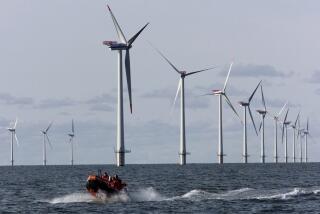Power Plant Is Opposed
- Share via
A power plant touted by Gov. Arnold Schwarzenegger and General Electric for its ability to reduce air pollution will actually spew nearly three times more unhealthful particulate matter into the air than older facilities, a coalition of environmental and labor groups said Wednesday.
The plant, under construction in the impoverished, largely Latino Riverside County community of Romoland, will sit about 1,000 feet from an elementary school, in a region that already suffers from the highest soot levels in the state.
“Any power plant built so near schools and families must follow clean air laws and not make our air quality any worse,” said Roland Skumawitz, superintendent of the Romoland School District. He said he recognized the need for power in the fast-growing Inland Empire, but preferred that GE and another company that has applied to build a second plant nearby help pay to move the school to a new site.
“This whole area is being targeted for these kinds of facilities,” said Penny Newman, executive director of the Center for Community Action and Environmental Justice in Riverside. She said GE’s application to the regional air district showed that while the new, so-called H-style turbine plant might reduce greenhouse gas-causing emissions slightly, it would nearly triple particulate emissions.
“You can’t trash a local community just because you may save a little somewhere else,” she said.
Riverside County already suffers from some of the state’s highest levels of particulate pollution, which studies have found can cause or worsen lung disease, childhood asthma and other illnesses.
Late Wednesday, the coalition mailed 60-day notices of intent to sue for violation of the Clean Air Act to the GE subsidiary building the $1-billion plant and to the South Coast Air Quality Management District, which in August issued a permit for the plant. But the group’s attorney, Marc Joseph of Adams, Broadwell, Joseph & Cardozo in South San Francisco, said it would prefer not to sue and just wants the project changed.
“We would be very happy if GE’s claim that this is a power plant that’s good for the environment were true, but at the moment, it’s not. What we are seeking is for GE to live up to its advertising.... The technology exists to have power plants which don’t increase downwind pollution illegally.”
Spokesmen for both General Electric and the air district said they had not received the complaint and could not comment.
GE Energy spokesman Dennis Murphy said the Romoland facility was the first of its kind in North America, and the second globally after a similar plant in Wales.
He said it was a demonstration plant to show that greenhouse gas emissions could be cut by increasing the efficiency of natural gas used.
“We’re very optimistic about the future of the technology,” he said. “The project is designed to be more environmentally compatible.”
As for the location, he said, “this was a very solid place to site the plant, to meet the needs of the entire area, which is very hungry for power.”
The plant has no commercial customers yet, but the power it generates could be sold on the state’s grid to serve 600,000 households, according to company officials and its website.
Greenhouse gas emissions are different ingredients of air pollution than particulate matter and are not regulated, said air district spokesman Sam Atwood. Particulates are regulated, but the notices allege that the agency ignored its own particulate standards to give special treatment to GE.
Countered Atwood: “We did a thorough review of their permit application, along with detailed modeling we required of them, and it did meet our requirements.”
The documents and Joseph also allege that the air district illegally allowed GE far cheaper “emissions offsets,” or payments for pollution, than market rate offsets that could cost millions more. The cheaper offsets were established for emergency providers such as hospitals, police and fire stations.
Atwood and attorneys for the air district noted that any application for a new power plant deemed complete by the California Energy Commission by the end of 2003, during the state energy crisis, could qualify to use the lower rates.
Calpine Corp., a power generator and the original site owner, applied for a traditional turbine plant permit that year, then sold the site, project name and approvals to GE last year. Schwarzenegger praised the agreement between the two utilities for a 775-megawatt power plant last year, saying in a statement that it was “fantastic news for California.... The plant’s planned use of state-of-the-art turbine technology will produce more power with lower emissions than any power plant in its class.”
Darrel Ng, the governor’s spokesman on energy issues, said Wednesday: “We’re going to decline comment on a lawsuit we are not party to.”
Bob Balgenorth, president of the California Building Trades Council and chief of a group known as California Unions for Reliable Energy, which is funding the legal challenge to the site, said the two groups have “no fight with the governor” and that Schwarzenegger may have been misinformed by the power companies.
“They claim they’re using state-of-the-art technology here. That’s what GE told everybody when they first filed the application, but their own numbers show a violation of federal laws. It’s crazy,” he said. “They promised us a diamond and they’re giving us zirconia. What you’ve got is a plant that actually produces more pollution than a whole previous generation of plants.”
More to Read
Sign up for Essential California
The most important California stories and recommendations in your inbox every morning.
You may occasionally receive promotional content from the Los Angeles Times.










